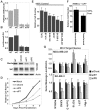PORCN moonlights in a Wnt-independent pathway that regulates cancer cell proliferation
- PMID: 22509316
- PMCID: PMC3324524
- DOI: 10.1371/journal.pone.0034532
PORCN moonlights in a Wnt-independent pathway that regulates cancer cell proliferation
Abstract
Porcupine (PORCN) is a membrane-bound O-acyl transferase that is required for the palmitoylation of Wnt proteins, and that is essential in diverse Wnt pathways for Wnt-Wntless (WLS) binding, Wnt secretion, and Wnt signaling activity. We tested if PORCN was required for the proliferation of transformed cells. Knockdown of PORCN by multiple independent siRNAs results in a cell growth defect in a subset of epithelial cancer cell lines. The growth defect is transformation-dependent in human mammary epithelial (HMEC) cells. Additionally, inducible PORCN knockdown by two independent shRNAs markedly reduces the growth of established MDA-MB-231 cancers in orthotopic xenografts in immunodeficient mice. Unexpectedly, the proliferation defect resulting from loss of PORCN occurs in a Wnt-independent manner, as it is rescued by re-expression of catalytically inactive PORCN, and is not seen after RNAi-mediated knockdown of the Wnt carrier protein WLS, nor after treatment with the PORCN inhibitor IWP. Consistent with a role in a Wnt-independent pathway, knockdown of PORCN regulates a distinct set of genes that are not altered by other inhibitors of Wnt signaling. PORCN protein thus appears to moonlight in a novel signaling pathway that is rate-limiting for cancer cell growth and tumorigenesis independent of its enzymatic function in Wnt biosynthesis and secretion.
Conflict of interest statement
Figures





Similar articles
-
Wnt family member 4 (WNT4) and WNT3A activate cell-autonomous Wnt signaling independent of porcupine O-acyltransferase or Wnt secretion.J Biol Chem. 2019 Dec 27;294(52):19950-19966. doi: 10.1074/jbc.RA119.009615. Epub 2019 Nov 18. J Biol Chem. 2019. PMID: 31740580 Free PMC article.
-
Responses of Porcupine and Wntless proteins to oxidative, hypoxic and endoplasmic reticulum stresses.Cell Signal. 2021 Sep;85:110047. doi: 10.1016/j.cellsig.2021.110047. Epub 2021 May 17. Cell Signal. 2021. PMID: 34015469
-
Divergent effects of Porcupine and Wntless on WNT1 trafficking, secretion, and signaling.Exp Cell Res. 2016 Sep 10;347(1):171-183. doi: 10.1016/j.yexcr.2016.07.028. Epub 2016 Aug 1. Exp Cell Res. 2016. PMID: 27492485 Free PMC article.
-
Modulating Wnt signaling at the root: Porcupine and Wnt acylation.Pharmacol Ther. 2019 Jun;198:34-45. doi: 10.1016/j.pharmthera.2019.02.009. Epub 2019 Feb 18. Pharmacol Ther. 2019. PMID: 30790642 Review.
-
The role of Evi/Wntless in exporting Wnt proteins.Development. 2023 Feb 15;150(3):dev201352. doi: 10.1242/dev.201352. Epub 2023 Feb 10. Development. 2023. PMID: 36763105 Free PMC article. Review.
Cited by
-
Everything you ever wanted to know about cancer stem cells in neuroendocrine neoplasms but were afraid to ask.Endocr Oncol. 2024 Dec 19;4(1):e240006. doi: 10.1530/EO-24-0006. eCollection 2024 Jan 1. Endocr Oncol. 2024. PMID: 39822777 Free PMC article. Review.
-
Wnt Lipidation and Modifiers in Intestinal Carcinogenesis and Cancer.Cancers (Basel). 2016 Jul 18;8(7):69. doi: 10.3390/cancers8070069. Cancers (Basel). 2016. PMID: 27438855 Free PMC article. Review.
-
Zygotic Porcn paternal allele deletion in mice to model human focal dermal hypoplasia.PLoS One. 2013 Nov 1;8(11):e79139. doi: 10.1371/journal.pone.0079139. eCollection 2013. PLoS One. 2013. PMID: 24223895 Free PMC article.
-
Multiple requirements of the focal dermal hypoplasia gene porcupine during ocular morphogenesis.Am J Pathol. 2015 Jan;185(1):197-213. doi: 10.1016/j.ajpath.2014.09.002. Epub 2014 Nov 3. Am J Pathol. 2015. PMID: 25451153 Free PMC article.
-
Porcupine is not required for the production of the majority of Wnts from primary human astrocytes and CD8+ T cells.PLoS One. 2014 Mar 19;9(3):e92159. doi: 10.1371/journal.pone.0092159. eCollection 2014. PLoS One. 2014. PMID: 24647048 Free PMC article.
References
-
- Coombs GS, Covey TM, Virshup DM. Wnt signaling in development, disease and translational medicine. Curr Drug Targets. 2008;9:513–531. - PubMed
-
- Polakis P. The many ways of Wnt in cancer. Curr Opin Genet Dev. 2007;17:45–51. - PubMed
-
- Kadowaki T, Wilder E, Klingensmith J, Zachary K, Perrimon N. The segment polarity gene porcupine encodes a putative multitransmembrane protein involved in Wingless processing. Genes Dev. 1996;10:3116–3128. - PubMed
-
- Tanaka K, Okabayashi K, Asashima M, Perrimon N, Kadowaki T. The evolutionarily conserved porcupine gene family is involved in the processing of the Wnt family. Eur J Biochem. 2000;267:4300–4311. - PubMed
-
- Caricasole A, Ferraro T, Rimland JM, Terstappen GC. Molecular cloning and initial characterization of the MG61/PORC gene, the human homologue of the Drosophila segment polarity gene Porcupine. Gene. 2002;288:147–157. - PubMed
Publication types
MeSH terms
Substances
LinkOut - more resources
Full Text Sources
Other Literature Sources
Medical
Miscellaneous

